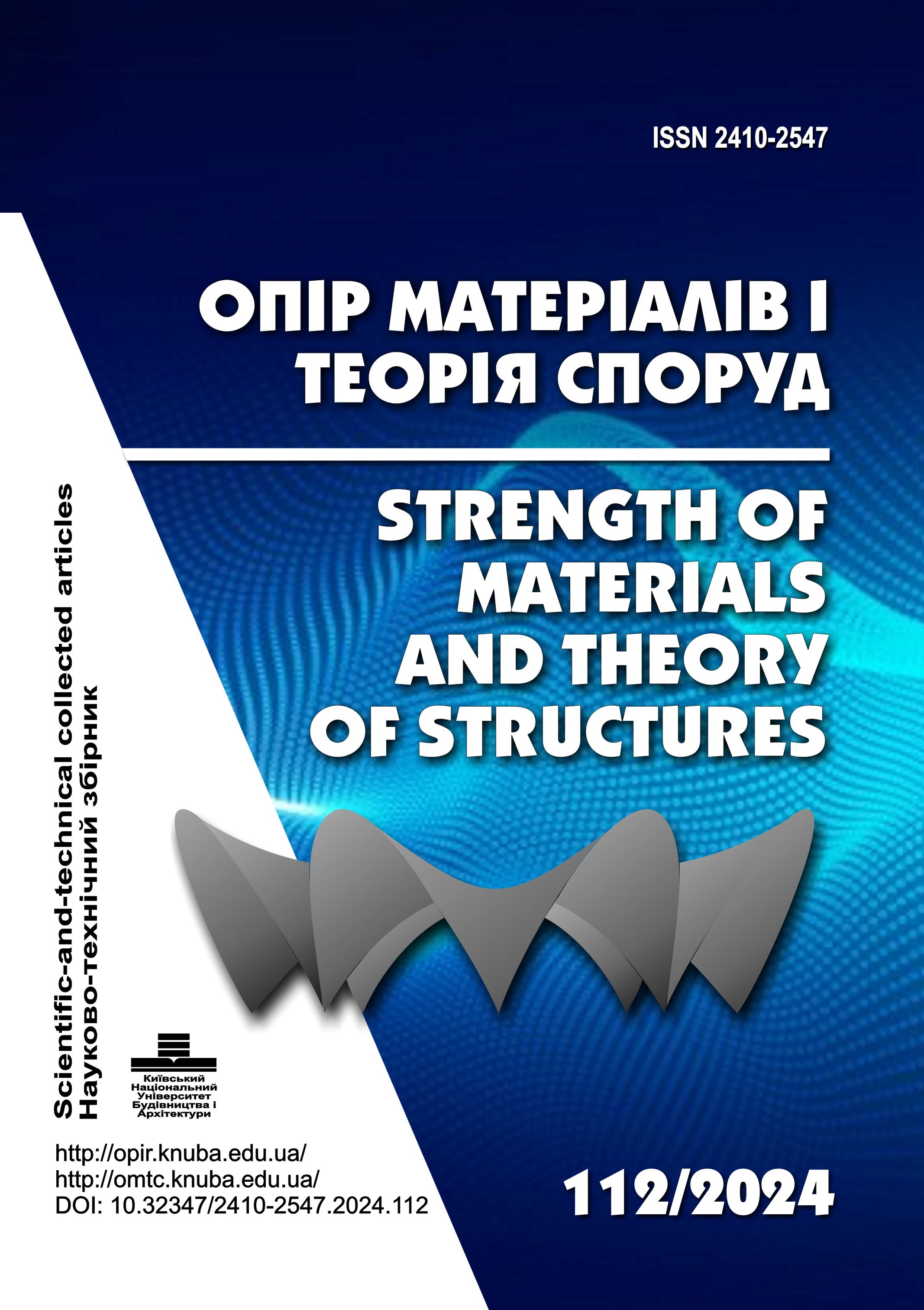Strength analysis and force distribution in a tensile metal joint
DOI:
https://doi.org/10.32347/2410-2547.2024.112.36-42Keywords:
semi-analytical finite element method, finite element method, bolted connection, contact stresses, stress concentration factorAbstract
One of the methods of connecting several elements of mechanical structures to form an assembly is bolting. Unlike other types of connections, such as welding or riveting, this type of connection has the advantage of being disassembled, which is why bolted connections are quite common. At the same time, like other types of connections, it is an important structural element that requires additional attention in calculations. The most common calculation of a bolted connection is using analytical formulas.
Every day, the requirements for accuracy, speed and versatility of approaches to the calculation of building structures are increasing. In addition, special attention should be paid to the calculation of nodes where structures abut each other, since depending on the operating conditions of the node, different distribution of the NDP is possible, which in turn affects the geometr2ic characteristics and operation of structures.
In this regard, we compared the results of the distribution of stresses and forces in the bolt using the finite element method with the use of universal quadrilateral shell FEs, universal spatial eight-node isoparametric FEs, and the semi-analytical finite element method.
The obtained results of solving the test case using universal quadrilateral shell FEs and universal spatial eight-node isoparametric FEs allow us to conclude that there is a slight difference in the stress distribution in the spatial formulation of the FEM and SFEM. In addition, based on the FEM and NEM calculations and, accordingly, the calculation according to the DBN, it can be concluded that when calculating according to the DBN standards, an analytical calculation can be used to determine the safety margin of a bolt for simple tasks.
References
Bazhenov V.A., Piskunov S.O., Shkryl O.O. Semi-analytical method of finite in the problems of fracture of bodies with cracks // K.: Caravel, 2017. - 208 p.
Vabishchevych M.O., Storchak D.A.. Solving nonlinear contact problems of deformation of nodal joints of steel structures. Resistance of materials and theory of structures, Issue 108, 2022, pp. 178-179.
Gulyar O.I., Piskunov S.O., Mitsyuk S.V. Determination of the resource of the connecting fitting under conditions of multi-cycle loading in the presence of initial defects.
DBN B.2.6-198:2014 Steel structures. Design standards
Pisarenko GS, Kvitka OL, Umansky ES. Resistance of materials. Textbook - 2nd ed. And revised - K.: Higher school, 2004. -655с.
Piskunov S.O., Mitsiuk S.V., Andrievsky V.P., Mitsiuk D.V. Comparative analysis of the results of calculation of the frame assembly in the IDEA STATICA CONNECTION software and according to the methods of regulatory documents // Resistance of materials and theory of structures: scientific and technical collection - Kyiv: KNUBA, 2022. - Issue 109. - P. 31-39.
Solodey I.I., Kozub Y.G., Stryhun R.L., Shovkivska V.V. Analysis of algorithms for solving geometrically nonlinear problems of mechanics in the scheme of the semi-analytical finite element method.
Maksymiuk Y.V., Martyniuk I.Y., Kozak O.V., Maksymiuk O.V.. Numerical analysis of the stressed-deformed state of a tubular element under thermal loading // Resistance of materials and theory of structures. -K.: KNUBA, Issue 110, 2023, pp. 199-206.
Bazhenov, V.A., Pyskunov, S.O., Maksym’yuk Yu.V., Mytsyuk S. V. Effect of geometric nonlinearity on the life of a herryingbone lock joint in creep // Strength of Materials, 2022, Vol. 54, No. 3, pp.372-376.
Pyskunov S. Maksimyuk Yu., Maksimyuk О. Basic relationships for physically and geometrically nonlinear problems of deformation of prismatic bodies // Strength of Materials and Theory of Structures – 2020. – Vol. 104 . – С. 255-264
Frederick F. LingContact Stresses and Deformations, ME EN 7960-Precision Machine Design Topic 7, 2007
Suranaree J. Sci. Technol. Vol. 14 No. 4; October-December 2007. Simulation and Experimental Work of Single Lap Bolted Joint Tested in Bending. Aidy Ali*, Ting Wei Yao, Nuraini Abdul Aziz, Muhammad Yunin Hassan and Barkawi Sahari.
Downloads
Published
Issue
Section
License

This work is licensed under a Creative Commons Attribution 4.0 International License.
Authors retain copyright and grant the journal right of first publication with the work simultaneously licensed under a Creative Commons Attribution License that allows others to share the work with an acknowledgement of the work's authorship and initial publication in this journal.

